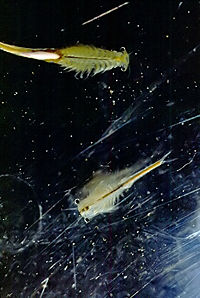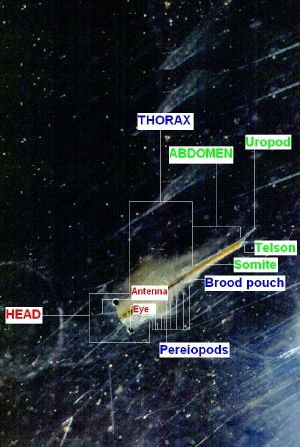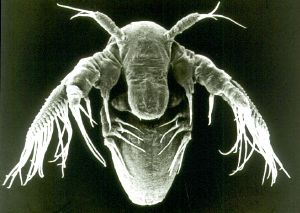Fairy shrimp
| Fairy shrimp | ||||||||||||
|---|---|---|---|---|---|---|---|---|---|---|---|---|
| Adult fairy shrimp Adult fairy shrimp
| ||||||||||||
| Scientific classification | ||||||||||||
| ||||||||||||
|
Artemiidae Grochowski, 1896 |
Fairy shrimp (Anostraca) are branchiopods that include brine shrimp. They often appear in vernal pools, pot holes and other ephemeral pools. Although they live in fresh or saltwater they do not live in oceans or seas. They are well-adapted to living in arid areas where water is present for only part of the year. Their eggs will survive drought for several years and hatch about 30 hours after rains fill the pools where they live. Some eggs may not hatch until going through several wet/dry cycles, ensuring the animals' survival through times that the pools don't last long enough for the shrimp to reproduce.
The Western United States (especially California) is home to many species of fairy shrimp, five of which are threatened or endangered: the vernal pool fairy shrimp (Branchinecta lynchi, threatened), the Conservancy fairy shrimp (Branchinecta conservatio, endangered), the San Diego fairy shrimp (Branchinecta sandiegonensis, endangered), the longhorn fairy shrimp (Branchinecta longiantenna, endangered), and the Riverside fairy shrimp (Streptocephalus wootoni, endangered). All these listed species are endemic to the west coast, some found in fewer than a dozen populations in a very small area. The vernal pool fairy shrimp (Branchinecta lynchi) was thought to exist only in California until a population was discovered in the Agate Desert area of Oregon in 1998.
Although most fairy shrimp are small (under ½ inch, 1 cm), the largest species are over 6 inches (15 cm) long and are predatory on other fairy shrimp. The giant fairy shrimp (Branchinecta gigas) is the largest and is found in the playas of California's southern deserts. This species traps the much smaller alkali fairy shrimp (Branchinecta mackini) with its large antennae. In contrast, the newly-discovered giant fairy shrimp Branchinecta raptor from Idaho has modified raptorial phyllopodia, which it uses to stab and puncture its prey.
Characteristics
The body of a fairy shrimp is distinctly separated into head, thorax, and abdomen. The head consists of two sections - the first one with the antennae and eyes, and the second one bearing the jaws (mandibles and maxillae). The first pair of antennae, known as antennules, are usually of considerable length, but not segmented. The second pair, however, is more muscular, especially in males. The males use their antennae to grasp females while mating. In some males these antennae are equipped with numerous outgrowths and are quite unusual in shape. At the sides of the head is a pair of stalked compound eyes and an unpaired naupliar eye at the top of the head.
The mandibles are strong but bear no palps, and the maxillae are primitive in structure. In front of the mandibles is a hoodlike upper lip which hinders the flow of water towards the mouth.
In most fairy shrimps the thorax consists of 11 segments and a few have 17-19 thoracic segments. Every segment bears a pair of leaflike legs. They are all similar in structure, and every leg has 2 or 3 lobes on the outer side, which contain the breathing organs, and one lobe for paddling. On the inner side are 6 lobes that push the water to the mouth opening. On the ventral side of the body is a deep groove inside which the water flows to the mouth.
The abdomen is cylindrical and consists of 8 segments and a telson plate.
Reproduction
During mating, the male swims under the female and grasps her with his antennae. He may hold on from several minutes to several days, and then the crustaceans separate. Inside the female's body the eggs are wrapped in yolk and a strong shell which is, in certain species, equipped with spikes or bumps. The eggs are released by the female into her egg sac, 2-3 days after mating, but next are dumped into the water and sink to the bottom, where they start developing. Females can produce two types of eggs, thin shelled "summer" eggs and thick shelled "winter" eggs. The type of egg produced is determined by the number of males in the community; summer eggs will be produced if there is a shortage of males in the population. Summer eggs hatch rapidly; the young form while still inside the brood sac. The young from these eggs will populate the pool during the same season they are laid. The winter eggs remain in the mud at the base of the pool and dry out with the pool. The eggs will hatch in the spring when the pools refills. Though the resting period usually varies between 6 to 10 months, eggs have been hatched in a laboratory after 15 years. Eggs have been subjected to temperatures of as high as 99C and as low as -190 C and remained viable. Winter eggs usually hatch 30 hours after being exposed to water.
External links
ReferencesISBN links support NWE through referral fees
- Follo, J., and D. Fautin. 2001. Branchiopoda. Animal Diversity Web (online). Retrieved May 26, 2008.
- Hobbs, H. H. 2003. Crustacea. In Encyclopedia of Caves and Karst Science. Routledge. Retrieved December 5, 2006.
- Myers, P., R. Espinosa, C. S. Parr, T. Jones, G. S. Hammond, and T. A. Dewey. 2008a. Class Branchiopoda (branchiopods). The Animal Diversity Web (online). Retrieved May 26, 2008.
- Russell-Hunter, W. D. A Biology of Higher Invertebrates. London: Macmillan Company, 1969.
Credits
New World Encyclopedia writers and editors rewrote and completed the Wikipedia article in accordance with New World Encyclopedia standards. This article abides by terms of the Creative Commons CC-by-sa 3.0 License (CC-by-sa), which may be used and disseminated with proper attribution. Credit is due under the terms of this license that can reference both the New World Encyclopedia contributors and the selfless volunteer contributors of the Wikimedia Foundation. To cite this article click here for a list of acceptable citing formats.The history of earlier contributions by wikipedians is accessible to researchers here:
The history of this article since it was imported to New World Encyclopedia:
Note: Some restrictions may apply to use of individual images which are separately licensed.
- ↑ L. A. Zenkevich. The Animal Life (Zhizn' Zhivotnykh), Volume 2. Chapter 7 - Phylum Arthropoda.



